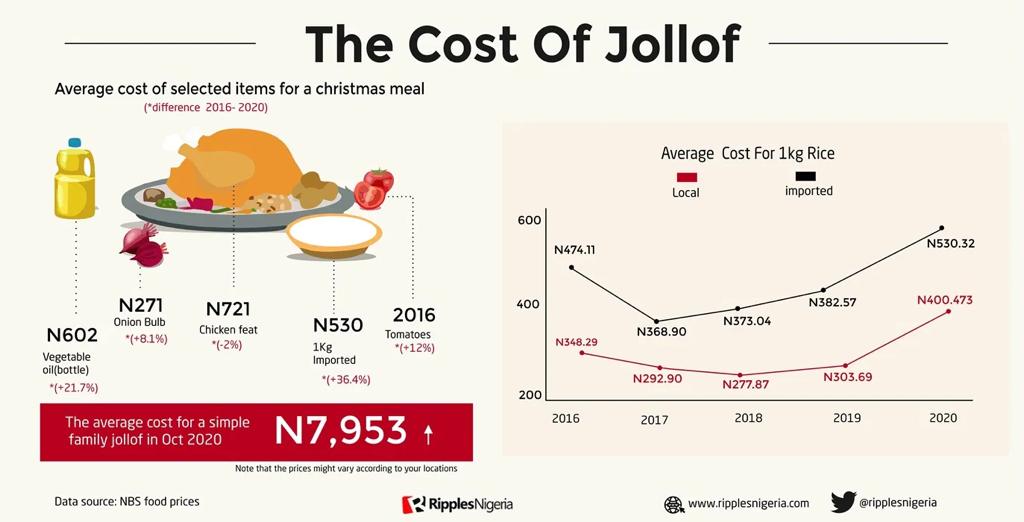Business
Cost of making jollof rice jumps 81% in five years

For many Nigerian households, the relentless rise in food prices has meant constantly having to make tough decisions monthly, Skip meals or rationalize.
This feeding burden for households was further made clearer by SBM Intelligence, a research firm in its March 2021 jollof rice index.
According to the research firm, it now costs N7,400 as at March 2021 to make a pot of jollof rice, 81 percent more than the N4,087 it cost in July 2016, for a family of five or six.
What this means is that for an average Nigerian on a minimum wage of N30,000, it will now have to sacrifice 25 percent of the salary to prepare a pot of jollof rice.
This confirms Ripples Nigeria’s earlier report on how it is becoming very expensive to prepare a pot of jollof rice for households in the country.
RipplesMetrics, had based its figures from the National Bureau of Statistics, and market survey to extrapolate that preparing a pot Jollof increased to N7953.03, from N5131.87 in 2016 ahead of the Christmas celebration.
According to figures at that time, the cost of rice (Imported) across the country, the main ingredient in Jollof, increased from N19,439 for a 50kg in 2016 to N26,512 as at December last year.
The Jollof Index tracks the costs of making a pot of Jollof rice across 13 markets in the six geopolitical zones for a family of five or six, in rural and urban family size.
The report further revealed that the most expensive places to make a pot of Jollof is Wuse and least costly at Awka.
SBM intelligence also pointed at the high exchange rate of N410/$1 to N475/$1 in the parallel market as one of the reason the price of jollof rice has continued to rise.
Read also: Rising prices of food items highlight struggle of Nigerian households —NBS
The ingredients strongly affected by the exchange rate the report said, included prices of tomato puree, rice, turkey, and seasoning.
“In all the states surveyed, out of a score of 50, the combined score ranged from 18-27 which shows a general decline in entitlements across the states and similar levels of severity. While Bauchi has a higher chance at getting food insecure, the other states are slightly above the borderline, showing a medium decline in their entitlement (ability to get food).”
Food inflation data for March released on Thursday by the National Bureau of Statistics (NBS) revealed that between March 2015 and March 2021 the price of food rose by 153.06 percent.
The monthly composite food index rose from 172.8 in March 2015 to 429.7 index points in March 2021.
Year on year food inflation increased to 22.95 percent in March 2021.
Join the conversation
Support Ripples Nigeria, hold up solutions journalism
Balanced, fearless journalism driven by data comes at huge financial costs.
As a media platform, we hold leadership accountable and will not trade the right to press freedom and free speech for a piece of cake.
If you like what we do, and are ready to uphold solutions journalism, kindly donate to the Ripples Nigeria cause.
Your support would help to ensure that citizens and institutions continue to have free access to credible and reliable information for societal development.
























